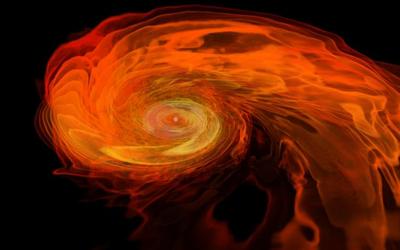Gravitational waves provide new way of studying the universe
The European Space Agency (ESA) has announced that it will create an observatory in space to detect ripples in the fabric of space-time, known as gravitational waves, which are created by celestial objects with very strong gravity, such as the merging of black holes. Researchers say this will expand the way in which they can observe the universe.
Gravitational waves were predicted by Einstein’s theory of general relativity but they have never been detected directly before, as they do not give off light or an electromagnetic signature. The waves are thought to be created by violent cosmic events and by the gravitational forces of massive bodies such as stars and planets moving asymmetrically, ‘tugging’ at each other and making waves in space-time.

The suggested mission to probe the gravitational universe is the evolved Laser Interferometer Space Antenna (eLISA). The all-sky monitor is expected to open up hidden chapters in the history of the universe by listening to the waves made by the earliest black holes, by thousands of pairs of stars, and probably by the Big Bang. It will provide powerful insight into the fundamentals of gravity and, by seeing how the waves from early black holes are stretched out as they move through the expanding universe, it will even study dark energy.
The mission, planned for launch in 2034, is an international effort involving researchers at institutions across Europe, the USA and Australia. Imperial College London is one of the core team of 10 European institutions who have been working on this project since the mid-1990s.
“Over the centuries, astronomy has grown to cover more and more of the electromagnetic spectrum, seeing more colours if you like, whether visible light, infrared, X-rays or submillimetre,” said physicist Professor Tim Sumner, who leads the work on eLISA at Imperial College London.
“With gravitational waves, we’ll have a totally different way of collecting information. It’s as though we’ve been watching a television with the sound off and now we’re going to be able to turn the sound up and have a much clearer sense of what’s happening.”
Gravitational waves carry with them information about their origins and about the nature of gravity that cannot be obtained using other astronomical tools. Thus, said Professor Sumner, “We’ll be able to get to grips with black holes; see how gravity works more precisely than ever before; and potentially even see what happened in the seconds after the Big Bang.”
The eLISA mission will place three spacecraft, 1-5 million km apart, halfway between the Sun and the Earth. In this position, the gravitational pull will lock the craft in a stable position so they can orbit the Sun at the same speed as the Earth. In each one there will be a device known as a ‘proof mass’. Lasers will watch over the proof masses to detect any movement that indicates a gravitational wave passing between them. Scientists will need to develop an ambitious spaceborne gravitational wave observatory, or extreme precision ‘gravitometer’, for the mission.
The gravitometer follows on from an ESA test mission known as LISA Pathfinder, which is due to launch in 2015. Karsten Danzmann, director at the Max Planck Institute for Gravitational Physics and professor at Leibniz Universität Hannover, said all the technology being developed for eLISA will get its first test in space with the launch of the LISA Pathfinder mission. The technology will be optimised between 2014 and 2020 and industrial implementation will begin in 2024, before launch in 2034.
European Space Agency inaugurates deep space antenna in WA
The ESA has expanded its capability to communicate with scientific, exploration and space safety...
Black hole collision supports Hawking's landmark theory
Astrophysicists have witnessed a collision between two black holes that was so loud, they were...
Uncovering differences in wild and domesticated crops
Researchers have revealed insights into the genetic make-up of wild varieties of common crops...





